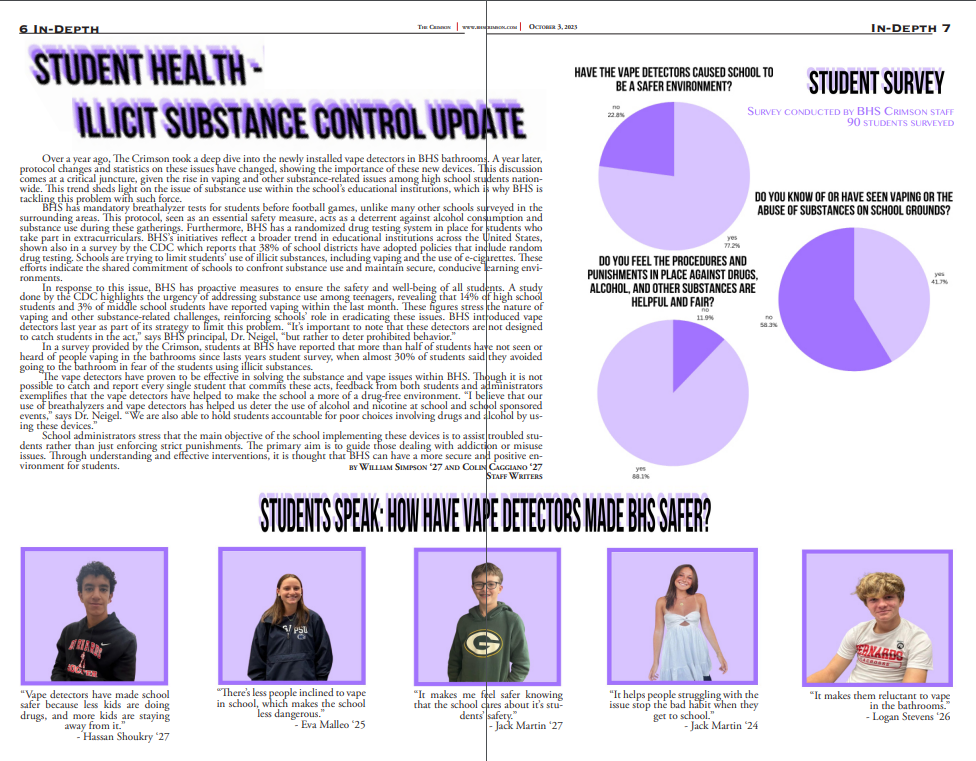The use of e-cigarettes has become an epidemic that has swept through the entirety of the United States rapidly. The Truth Initiative, a prominent organization founded to eliminate youth smoking, has cited that in their 2020 survey, they’ve found that 19.6% of all highschool students use e-cigarettes, with 27.6% of those teens using e-cigarettes daily.
To counter this, BHS has installed FlySense vape detectors. These smoke detector-like alarms send notifications to each school administrator throughout BHS, including Dr. Neigel, Dr. Corbett, and Mr. Hoppe, when any nicotine or miscellaneous drug is detected in the air. They are located in the A300 bathrooms, as well as the B200, B300, Cafeteria restrooms, along with locker rooms. Each administrator receives a notification through text and email telling them exactly what time and in which location there is vapor detected.
This started as a way to ultimately help the student body overcome their troubling substance dependencies. These devices are being used to “deter the behavior” of students using these harmful and illegal substances. Feedback from across the student body at BHS has stated that there is a significant decrease in noticeable vaping throughout the school. John Tober, ‘24, believes that “the Vape Detectors are very effective in reducing the amount of students that vape in the bathrooms.” However, just over 35.2% of students surveyed disagree with him, with over 27% saying that even with the installation of these new preventative devices, they’re still scared to use the restrooms due to the risk of being searched due to another student’s actions. John continues to say that “Last year I would avoid going to the bathrooms because there were always so many students vaping”, leaning towards their positive effects.
The general goal of the installations was to help the students. All of the administrators agreed that instead of this being a new way to “catch a student”, it’s being used as a way to help their overall health and the environment at BHS. Dr. Corbett stated that “our primary goal is to encourage students to make better decisions” and also proceeded to add that the school district wants students to realize there’s a consequence, be it health-wise or school consequences.
The course of action through these alarms is still in progress. As of right now, when a detector in any of the bathrooms goes off, one administrator that receives an alert will attend to the scene as soon as possible. There are cameras outside of the bathrooms to watch students who enter and leave the bathrooms during the time when the e-cigarettes are detected, allowing administrators to further investigate the issue. Students can be searched if there is reasonable suspicion that they were vaping in the bathrooms, and policy states that they are also subjected to a drug test if there is any illegal substance on their person. Dr. Neigel, as well as the police and the school district as a whole, are working to refine this process and find a consequence that benefits the students and the school. He stated that if a vape is found to definitively have only nicotine, it’s too difficult to test for, but that if there is any other type of drug (marijuana, THC, etc.) being used, a drug test will be issued. “There’s a different consequence between nicotine and marijuana”, he says, and according to the severity of the action there will be a very different outcome.
These FlySense detectors were installed in the summer of 2022, while school was not in session. This idea had been circulating through the school district since early 2019, but BHS has just recently received a grant for ten FlySense detectors and their installation through the school from the Health and Wellness committee.
The real question: Are they effective? Just over 75% of all students surveyed about the issue believed that there has been a significant difference in the amount of students using the bathrooms to vape this school year versus last. Both Dr. Neigel and Dr. Corbett stated that they have received many fewer alerts per day in the fourth week of the school year in comparison to the first. Dr. Neigel used to average fifteen alerts per day at the beginning of the activation of these devices, and now is only averaging ten each day.
These detectors are helpful and are increasing the safety of all of the students through BHS. The detectors, as well as the camera systems, have recently received backlash from some of the student body, with anonymous statements such as “they don’t make sense” and “a more effective approach could be taken”. One student even went so far as to say “I don’t think beeping machines are going to stop the nicotine crisis half the school is facing. Get real, the only thing it’s doing is forcing kids to find loopholes.”
Whether this is true or not, there are certainly contrasting beliefs between the student body and the views of staff and administrators. “95% of the students are not vaping, but it’s as much about the 95% of the students who aren’t as it is the 5% of students who are,” closes Neigel.












